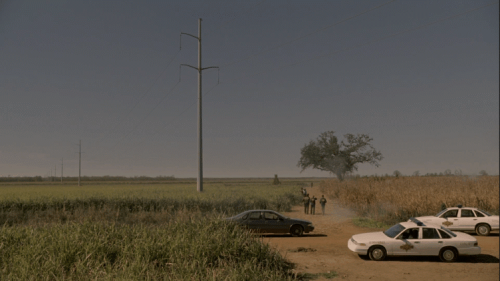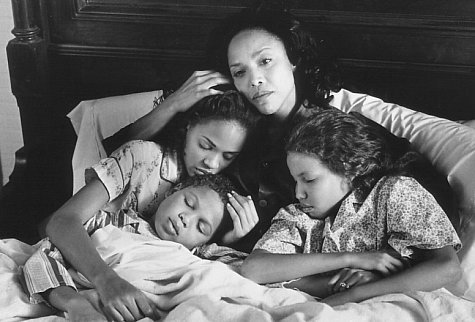This guest post by Lisa Shininger previously appeared at her site and appears now as part of our theme week on Dystopias. Cross-posted with permission.
Spoilers ahoy.
I’m tired today.
I stayed up too late last night to watch the first season finale of True Detective, the lush, loquacious portrait of Southern decay that held me in thrall all weekend, racing to catch up to the zeitgeist, if not the killer(s). I’m no stranger to late nights—nor to the toll of an extended media binge—but the seemingly endless spin of the HBO Go loading wheel (and the horrified contortions of my face once the show began) were more tiring than I had expected.
More than that, though, this tiredness also stems from choosing for a weekend to almost wholly submerge myself in the barely fictional, humanity-ravaged landscapes of Louisiana. The glimpses we had of the fading memory of a town—of man-made structures being devoured by the march of time and nature—mirror the Rust Belt city I live in, where my drive to work has been carefully mapped around abandoned factories and crumbling facades so the unrelenting misery of impotent nostalgia doesn’t get its claws too deep into me.
There is no escape from Pizzolatto and Fujinaka’s post-apocalyptic vision in the world of True Detective. Rust and Marty end almost where they began, but they will be forever tied to that land that sinks ever further out of sight.
Sometimes it feels like there is no escape in my neck of the woods, either. While no swirling, galactic vortices yawn open above my head, I see hints of humanity’s high-water mark in every rusted fence falling inexorably beneath a new grassy tide.
That’s not entirely why I’m tired today, though.
Sure, I’m tired of driving through familiar post-industrial wastelands, of hearing the echoes of a Springsteenian wail with every mile, both in reality and in fiction.
And I’m tired of the artistic fetishization of decline, of photo essays about the crumbling American industrial civilization with little or no context for the societal forces that precipitated that decline, and those that continue to accelerate it while we avail ourselves of disaster porn.
But, at the end of the day—at the end of a lot of days—I’m tired of watching these shows and seeing women as props and symbols used to push the hero along his way. I’m tired of watching these shows and seeing the massive chasms between what they present, what they claim to represent, and what their fans insist they represent.
I’m tired of watching these shows be widely praised for the quality of their writing, their fully dimensional characters, their gritty and realistic depictions of life—while I’m wondering where the other half of the world is.
In high school, I fell hard for The X-Files. Harder than for any other thing in my life, before or since. It fed my adolescent desire for darkness and the occasional lingering shot of David Duchovny’s fishbelly-pale torso.
The infamous fourth season episode, “Home,” touched on some of the same themes and archetypes revealed through this season of True Detective. The abduction and violation of women. The high American Gothic horror of the backwoods inbred. The willful ignorance of what happens in our communities. The invisible threads of malice and terror that we imagine—and occasionally reveal—crisscross our heartlands.
There, the monsters weren’t just the malignant and malformed Peacock men who roamed the Pennsylvania hills in their classic car to the dulcet tones of a Johnny Mathis sound-alike, in search of new breeding stock and targets for their violent protective urges. The monster was also the literal thing under the bed: the woman who presumably birthed them and continued to give birth to their doomed offspring. The episode hinges on Mulder and Scully seeking her out, to rescue her from her captors, from the horrors they assume she endures. But when Scully engages her, Mrs. Peacock reveals herself to be every bit the horror that her sons are. She is complicit and consenting—by the show’s terms—both in her confinement and in the rampages her sons commit.
We meet her presumable counterpart in the True Detective finale, but when the present-day detectives Gilbough and Papania begin to tell us her role among the evil that surrounds her, Marty Hart tells them to stop. He is as uninterested in her life as he is in that of any of the women who surround him, when their lives aren’t in support of his own. He is as uninterested in her life as the show is in the lives, or deaths, of any of the women we encounter.

From Elastic’s True Detective title sequence pitch, via Art of the Title
There’s always an argument to be made in favor of women-as-prop as an essential part of True Detective’s narrative and message. Over at The A.V. Club, Todd VanDerWerff says in a lengthy, weighty True Detective postmortem:
The most frequent criticism about this season has been its lack of “well-defined” female characters. This is a misleading statement. That there are no “well-defined” female characters on True Detective is the point.
Is it? Really?
It’s an essential part of the character of Marty, sure. His life outside the job is populated by women he barely knows: his wife, his children, his mistresses. It’s also an essential part of how Rust doesn’t allow himself to make connections with people—he only knows what he can see in service of his work.
But, how does the absence of women in the show—as viewpoint characters, as protagonists, as anything more complex than eyewitnesses and victims—further that point in ways that can’t be done within the narrative?
If the point of having no developed women—outside of Maggie, who I can’t forget never acts on anything unless it is in reaction to Marty—is to illustrate the disregard and disdain the world has for them, isn’t that point made in the way, for decades, dozens of women and children vanish and no one cares enough to pierce the veil of lies hung in their wake?
The question that kept ringing through my head as I mainlined the show was: Why are these always men’s stories? Monsters in myriad guises prey on women and children, but it’s always more men telling us stories about those monsters. Always.
If Pizzolatto’s aim in making this show was to transform the common beats and tropes of the murder story into something that transcended the genre, why do we have eight episodes that retread the most common of tropes: the victimization of passive women?
The inciting point of the entire season is the ritual murder of a woman and the destruction of property, which could arguably be seen as equivalent crimes. We first encounter Dora Lange as a literal object, a doll posed by unknown persons in a tableau that is as dehumanizing as it is unsettling. Greyed by death, frozen in a ritualized pose, crowned with antlers and transformed into a once-living sculpture: she is nothing but a piece of art, for whoever left her there, for Rust, and for us as well. The camera lingers on her naked flesh the way we imagine her killer might have done.
What more do we know about Dora Lange at the end of the season that we didn’t learn in those first scenes in the cane field? Rust tells us she is likely a prostitute, and so we learn she was. She had an ex-husband, who leads us into the mid-season digression into the hyper-macho world of drug dealers and undercover operations. How she came to be married to that man, working in that mobile home brothel, dead in that field, is only explained in the barest of strokes needed to move our heroes around their boards.
By the time we know that the men the show tells us are directly responsible for her murder are themselves dead, even Dora herself has been subsumed: by the detectives’ quest, by the horror visited upon her, by the monsters who set her death in motion, even by the young girl whose image has supplanted hers on Rust’s wall.
These are never stories told by women about how they’re preyed on. About how they try to protect themselves and fail, or how they succeed. About how they choose to be complicit in their own abuse, or how they never had a choice. These stories are never even about women who are preyed on. It’s always about men, and men, and men.
Lisa Shininger is a writer and designer from Dayton, Ohio. She cohosts Bossy Britches, and yells about pop culture at lisashininger.com and @ohseafarer.







